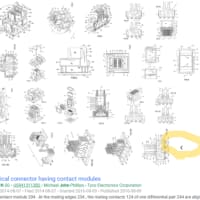WO2017031446
[0225J The decreasing responsivity with such shorter wavelengths presents difficulty i achieving a high performance silicon based photodiode in the violet or blue wavelength range. To overcome this difficulty blue enhancement and/or filter techniques can be used to improve the responsivity this wavelength range. In one embodiment an InGaN and/ or GaN-containing photodiode is combined with the integrated white light source. In another embodiment of this invention to overcome the difficulty of achieving a low cost silicon based photodiode operable with high responsivity in the blue wavelength region, a wavelength converter material such as a phosphor can be used to down convert ultraviolet, violet, or blue laser light to a wavelength more suitable for high-responsivity photo-detection according to the criteria required in an embodiment for this invention.
このようなより短い波長での受光感度の低下は、紫色または青色波長範囲の高性能シリコン系フォトダイオードを達成することを困難にする。この困難を克服するために、青色強化および/またはフィルタ技術(blue enhancement and/or filter techniques)を使用して、この波長範囲の受光感度を改善することができる。一実施形態では、InGaNおよび/またはGaN含有フォトダイオードが、一体型白色光源と組み合わされる。本発明の別の実施形態では、青色波長領域において高い受光感度で動作可能な低コストのシリコン系フォトダイオードを実現することの困難を克服するために、蛍光体などの波長変換材料を使用して、本発明の実施形態で要求される基準に従って、紫外、紫色または青色レーザ光を高感度光検出により適した波長にダウンコンバートすることができる。
WO2012040463
[0007] To compensate for limited illumination, the camera may have enhanced light collecting efficiency and registration capacity so that amounts of reflected light registered by pixels in the camera's photosensor are sufficient for signals the pixels generate to have acceptable signal to noise ratios (SNRs). Light collecting efficiency is a measure of an intensity (optical energy per unit area) of light imaged on the camera photosensor from that portion of light collected by the camera lens per unit area of an object that the camera images. Light registration capacity is a measure of how much signal that a pixel in the camera's photosensor produces per unit of optical energy that the camera images on the pixel and has units of signal magnitude per unit of optical energy. A product of a camera's light collecting efficiency and light registration capacity is a measure of the camera's sensitivity to light from a scene that it images and is referred to as the camera's light acquisition sensitivity (LAS).
[0007] 限られた照明を補うために、カメラは、当該カメラの光センサー内の画素により記録される反射光の量が、画素の発生する信号が許容可能な信号対雑音比(SNR)を有するのに十分となるように、増大した光収集効率と光記録容量を持つことができる。光収集効率は、カメラが撮像する物体の単位面積当りの、カメラのレンズによって収集される光の一部分からカメラの光センサー上で撮像される光の強度(単位面積当りの光エネルギー)の尺度である。光記録容量は、カメラが画素上に撮像する光エネルギーの一単位当りの、カメラの光センサー内の画素が生成する信号の量の尺度であり、光エネルギーの一単位当りの信号振幅の単位を有する。カメラの光収集効率と光記録容量の積は、カメラが撮像するシーンからの光に対するカメラの感度の尺度であり、カメラの受光感度(light acquisition sensitivity:LAS)と呼ばれる。
WO2005072224
[46] Another alternative is illustrated in Figs. 11 and 12, wherein an edge-emitting laser 250 is integrated with a surface-receiving detector 252 on a substrate 254, with a reflective base element 256 mounted on the surface of, or positioned above, the surface of the detector. The base element 256 includes a surface 260, which may be either flat or curved, and a dichroic filter 262 on surface 260. The filter may be a multilayer coating on the surface 260, which is designed to reflect one wavelength band and to allow another wavelength band to pass through. For example, a beam 264 emitted from facet 266 of laser 250, which may have a wavelength band of 1310 nm ± 40 nm (and which may be essentially s-polarized) and directed at an angle of 45° onto filter 262 will be almost completely reflected upwardly through external optics 266 to an input/output device such as optical fiber 268. Incoming light 270, which may have a wavelength band of 1490 nm ± 10 nm, also is directed at an angle of 45° to the filter 262, but this wavelength is almost completely transmitted through the filter to the underlying detector 252. As illustrated in the top view of Fig. 12, the received light 270 is directed onto the detector within the dotted line 272, including the region beneath the base element 256, to provide a greater area of detection, and thus greater sensitivity to received light.
基板254上で末端発信レーザ250が表面受光検出器252と統合され、反射ベース要素256が検出器の表面上に取り付けられ、または上方に位置決めされる他の代替手段は図11、図12に示されている。ベース要素256は、平面または曲面の表面260、および表面260上のダイクロイックフィルタ262を含んでいる。フィルタは、ある波長域を反射し、他の波長域を通過させるよう設計された表面260上の多層コーティングである。例えば、1310nm±40nmの波長域を持ち(実質的にs-偏光)、45°でフィルタ262に向けられ、レーザ250の面266から放射されるビーム264は、外部光学部品266を通して、光ファイバ268のような入力/出力デバイスに向けてほぼ完全に上方に反射される。 1490nm±10nmの波長域の入射光270もまた、45°の角度でフィルタ262に向けられるが、この波長はフィルタを通して下にある検出器252にほぼ完全に伝達される。図12の平面図に示されるように、受光270は、より大きな検出領域、およびそれによってより大きい受光感度を提供するため、ベース要素256の下の領域を含む、破線272の中の検出器に向けられている。
US20041215918
[0023] In an embodiment, the supporting device supports the x-ray irradiating device and x-ray receiving device at respective ends of a C-arm. In this case, diverse accesses to a subject are permitted. In an embodiment, the x-ray receiving device includes image intensifier so that the sensitivity to incident x-rays may be improved.
前記支持手段は前記X線照射手段および前記X線受光手段をC字状のアームの両端にそれぞれ支持することが、対象への多様なアクセスを可能にする点で好ましい。前記X線受光手段はイメージ・インテンシファイヤであることが、受光感度を良くする点で好ましい。
light reception sensitivity, optical reception sensitivity


























※コメント投稿者のブログIDはブログ作成者のみに通知されます